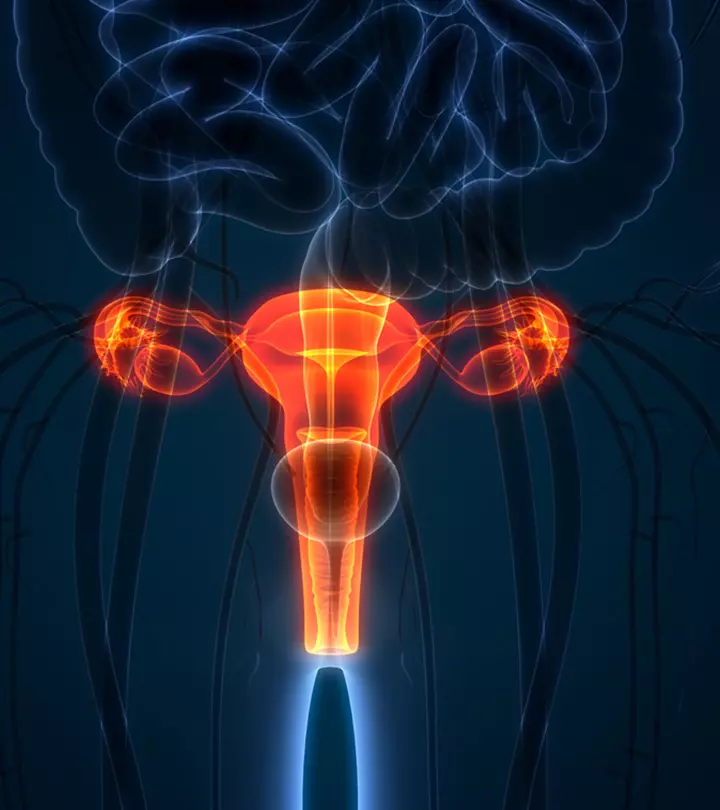

Image: Shutterstock
As a woman approaches her expected delivery date, she anticipates contractions before labor onset. However, this may not happen in some, and the doctor may suggest artificial labor induction to initiate contractions and facilitate childbirth. Labor induction and augmentation are widely chosen techniques among several women during childbirth. However, before opting for this practice, you must know its pros and cons. Read on to learn the reasons, risks, and noteworthy facts about induction and augmentation of labor.

What Is Labor Induction?
Labor induction is the artificial ripening of the uterine cervix to stimulate the uterine contractions and facilitate a vaginal birth.
When the body is ready to deliver the baby, it will signal the pituitary glands to release oxytocin to start the uterine contractions. The release will also cause loss of the cervical mucus plug and facilitate ripening of the cervix, which in turn will help with the onset of uterine contractions. These contractions will gradually increase in intensity and frequency, resulting in labor. The contractions tighten and thicken the upper part of the uterus (fundus), and stretch and relax the lower part of the uterus, and the cervix to facilitate the passage of the baby through the birthing canal (1).
In some cases though, women do not go into labor naturally. That is when the doctor resorts to bringing on the labor artificially by inducing labor. It is done with the help of medications or other tools and techniques (2).
What Are The Reasons For Labor Induction?
Your doctor may go for labor induction in the following cases (3):
Medical reasons
- Post-term pregnancy: If pregnancy prolongs beyond 42 weeks, then it is called overdue or post-term pregnancy. In such a case, labor is induced.
- Maternal health conditions: In case of pregnancy-induced hypertension, preeclampsia, or gestational diabetes, the doctor may recommend labor induction.
- History of precipitous labor: Precipitous labor is extremely rapid or quick delivery that lasts for three or less than three hours (4). Women who have had precipitous labor earlier will be subjected to labor induction after 37 weeks to ensure that the baby comes out at the right time, without any complications of precipitous labor (5).
- Premature rupture of membrane (PROM): If the water breaks before the onset of labor, doctors will induce labor.
- Intrauterine growth restriction: When the baby in the womb stops growing at a normal pace, medical assistance becomes necessary, and labor is induced a few weeks before your due date.
- Intrauterine fetal demise: In case of death of the baby inside the womb, after 20 weeks of pregnancy, labor induction will be carried out to take the fetus out.
- Oligohydramnios: If the amniotic sac contains insufficient fluid, depending on how far along in the pregnancy you are, the doctor may induce labor.
Non-medical reasons
- On request: Some women may request delivery induction on a specific date they choose based on astrology. Fatigue, extreme discomfort of pregnancy and the fear of stillbirth can also make the patient ask for labor induction.
- Favorable cervix: If the cervix is adequately dilated, then vaginal delivery after labor induction can be highly successful, without the risk of stillbirths.
Next, we learn about the different techniques of labor induction.
How Is Labor Induced?
Labor induction is done only after the doctor checks for cervix dilation. If a pregnant woman has a favorable cervix, then the doctor induces labor through (3):
- Membrane stretching and sweeping: The doctor will induce labor by inserting her fingers through the cervix that is partially dilated. After reaching the amniotic sac, the doctor will try to separate the membrane that connects the amniotic sac to the wall of the uterus. This separation causes the release of prostaglandins, which stimulate the contractions.
- Artificial rupture of membrane (ARM): If the baby’s head is fully engaged and the amniotic sac remains unruptured, then artificial rupturing of the membrane, also called amniotomy, will be carried out. In this method, the doctor uses a plastic hook to tear the amniotic membrane slightly. If the cervix is favorable for delivery, then this method will trigger the contractions.
If the cervix is unfavorable, the following methods are used:
- Cervical ripening: This method is for softening and dilating the cervix during labor. Following medicines and hormones are used for cervical ripening.
- Prostaglandins/ Dinoprostone: It is a hormone-like lipid compound available in the form of a gel that is inserted into the vagina or given orally in the form of a tablet. It helps in softening, thinning and dilating the cervix to start the contractions.
- Misoprostol: These are available in the form of pills that can be taken orally or inserted vaginally for cervical dilation to induce labor. However, oral administration is more effective than vaginal administration as per WHO. The oral dosage given is 20-25 mcg in every two hours, and vaginal dosage is more than 25 mcg given once every six hours (6).
- Transcervical balloon catheterization: This method involves insertion of a balloon catheter into the vagina for ripening the cervix gently. It is a soft narrow tube made of silicon with two small balloons at its edges. Once the tube is inserted, it is inflated to apply gentle pressure on the cervix, making it efface and dilate. Once the cervix opens up, the balloon will drop down. This method doesn’t cause overstimulation of the uterine contractions and facilitates vaginal birth (7).
- Synthetic oxytocin (Pitocin): This stimulant is given through an IV drip to initiate uterine contractions, but only after the cervix becomes favorable. During this procedure, the heartbeat of the baby is closely monitored. The synthetic oxytocin is given in small doses initially, and the dosage is gradually increased based on the intensity and frequency of the contractions.
These methods of labor induction help in initiating vaginal birth. If they fail, the doctor will do a c-section.
What Are The Risks Associated With Labor Induction?
Labor induction is usually safe, although in some cases there could be a few risks involved (8).
- Frequent and strong contractions due to the use of prostaglandins or oxytocins for artificial labor induction can increase the risks of uterine rupture and placental abruption, especially in the case of vaginal birth after cesarean.
- Prostaglandins and oxytocin can also disrupt the natural hormonal stimulation for labor, making an epidural necessary. The administration of epidural can further prolong the labor, thereby increasing the chances of assisted vaginal delivery using forceps or vacuum extraction, which is risky for both the mother and the baby.
- Elective labor induction can lead to the premature birth of the baby, between the 35th and 37th week, even though the due date is between 38 and 40 weeks or at 42 weeks. This situation arises when the doctor miscalculates your due date. Premature babies can have serious health complications and may have to be in the NICU for a specific period.
- The medicines administered to induce labor can lead to intense contractions. If the fetus cannot tolerate the pressure of contractions, then there will be a drop in the fetal heart rate. In some cases, the doctor may refuse to induce labor artificially. Find out more about it next.
When Is labor Not Induced?
Labor induction is not considered in the following cases (9):
- The shape of your pelvis makes vaginal delivery difficult, as the birthing canal will be smaller in comparison to the baby’s size.
- In case of fetal malpositions such as breech and transverse lie position.
- In the case of placenta previa.
- The mother had a previous cesarean section with a vertical incision on the uterus (classical incision) or other uterine surgeries such as removal of a fibroid.
- In multiple pregnancies, when one of the babies is not in the head-down position.
- In case of genital infections such as HPV causing extensive vaginal warts or herpes infection in the mother, the virus remains in the birthing canal. If vaginal delivery is attempted, then there is a high risk of passing the infection to the baby.
- Women with previous uterine rupture.
- Prolapsed umbilical cord.
- Abnormal fetal heart rate (fetal distress).
- Severe maternal hypertension.
- Polyhydramnios or excess amniotic fluid in the sac.
Sometimes, misinformation about labor induction can determine your decisions about labor induction. Read more about it next.
Myths About Labor Induction
Here are a few myths surrounding artificial induction of labor (5):
1. Labor induction is more painful than normal labor.
There is no substantial scientific evidence to prove this statement. However, labor induction will stimulate labor pains, which are natural.
2. Women experience some pain after prostaglandin insertion.
This is not always true, as the pain that some women experience could be due to the cervix dilating slowly.
3. Labor induction is unnatural.
No. Labor induction is only a technique to kick-start the labor, after which the birthing process proceeds naturally.
Labor induction should not be confused with labor augmentation, which is a procedure that is helpful after the onset of labor. Find out more next.
What Is Labor Augmentation?
In some pregnancies, labor pains may start naturally but will not progress faster. The contractions will not be forceful and regular enough for cervical dilation. In such a case, the doctor tries to further the contractions for the smooth progression of labor. Such an intervention is known as labor augmentation.
Why And How Is Labor Augmented?
Labor is augmented in the following cases (10):
- If you are in active labor but the amniotic sac is not broken.
- If the contractions are irregular or stop mid-labor.
- If your water broke, but the labor is not advancing.
Labor augmentation is done by:
- The stretch and sweep method
- Artificially rupturing the membrane
- Inserting medicines (e.g., Pitocin) into the vagina or administering them through IV or orally.
- You can also augment labor naturally, by walking as long as you can.
Labor augmentation is usually safe since it only aims at progressing the birthing process.
What Are The Risks Associated With Labor Augmentation?
The only risk of augmentation is posed by the administration of excess oxytocin, which can overstimulate the uterine contractions. In such case, the doctor can lower the dose or stop administering the medication for a while. In some cases, this can make the baby intolerable to the stress of excessive contractions and lead to a c-section delivery.
Frequently Asked Questions
1. How long does it take to birth a baby after being induced?
The duration between the induction and the birth of a baby is dependent on how the body responds to the treatment. Generally, it might last a few hours or extend for two to three days (11).
2. Is it better to wait or be induced?
If the mother and the baby are healthy, it is recommended to wait for full-term before the labor is induced. However, if there are any underlying conditions, your doctor may recommend a labor induction (12).
3. Do inductions lead to more C sections?
Labor inductions do not lead to C-sections in most cases. However, if the mother cannot proceed with a vaginal birth even after labor induction or if there has been another complication, the doctor might perform a cesarean (13).
Labor induction is the process of ripening the cervix through various interventions to induce uterine contractions for vaginal birth. Post-term pregnancy, maternal health conditions such as gestational diabetes, less amniotic fluid, and premature membrane rupture are common reasons to induce labor. Cervical ripening, stretching, or breaking the membranes are some of the labor induction methods. However, these methods are not frequently used since cesarean delivery is recommended in cases of complications. Oxytocin and other medications are also used to enhance uterine contractions to induce labor.
References
- Labor contractions.
https://www.sutterhealth.org/health/labor-delivery/labor-contractions - Labor Induction.
https://www.acog.org/womens-health/faqs/labor-induction?utm_source=redirect&utm_medium=web&utm_campaign=otn - Inducing labor.
https://kidshealth.org/en/parents/inductions.html - Shunji Suzuki; (2015); Clinical Significance of Precipitous Labor.
https://www.ncbi.nlm.nih.gov/pmc/articles/PMC4285060/ - Induction of labor.
https://www.healthhub.sg/live-healthy/pregnancy-induction-of-labour - WHO recommendations for Induction of labour.
https://apps.who.int/iris/bitstream/handle/10665/44531/9789241501156_eng.pdf;jsessionid=F73F751E9DCB584385657673AD718C28?sequence=1 - W. Rath and S. Kehl; (2015); The Renaissance of Transcervical Balloon Catheters for Cervical Ripening and Labour Induction.
https://www.ncbi.nlm.nih.gov/pmc/articles/PMC4678052/ - Judith A. Lothian; (2006); Saying “No” to Induction.
https://www.ncbi.nlm.nih.gov/pmc/articles/PMC1595289/ - Jefferson H. Harman, Jr. and Andrew Kim; (1999); Current Trends in Cervical Ripening and Labor Induction.
https://www.aafp.org/pubs/afp/issues/1999/0801/p477.html - Labor Induction and Augmentation.
https://www.uofmhealth.org/health-library/hw194662 - Induced labour.
https://www.pregnancybirthbaby.org.au/induced-labour#:~:text=There%20are%20different%20options%20for - Medical reasons for inducing labor.
https://www.pregnancybirthbaby.org.au/induced-labour#:~:text=There%20are%20different%20options%20for - Induced labor at 39 weeks may reduce likelihood of C-section, NIH study suggests.
https://www.nih.gov/news-events/news-releases/induced-labor-39-weeks-may-reduce-likelihood-c-section-nih-study-suggests
Community Experiences
Join the conversation and become a part of our nurturing community! Share your stories, experiences, and insights to connect with fellow parents.
Read full bio of Dr. Kofi Kwaw-Asante
Read full bio of shreeja pillai















